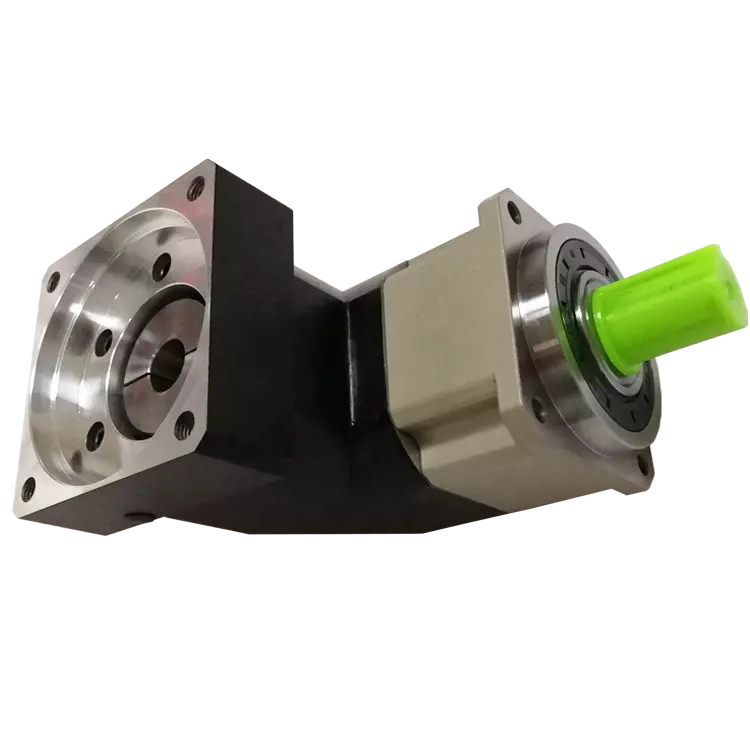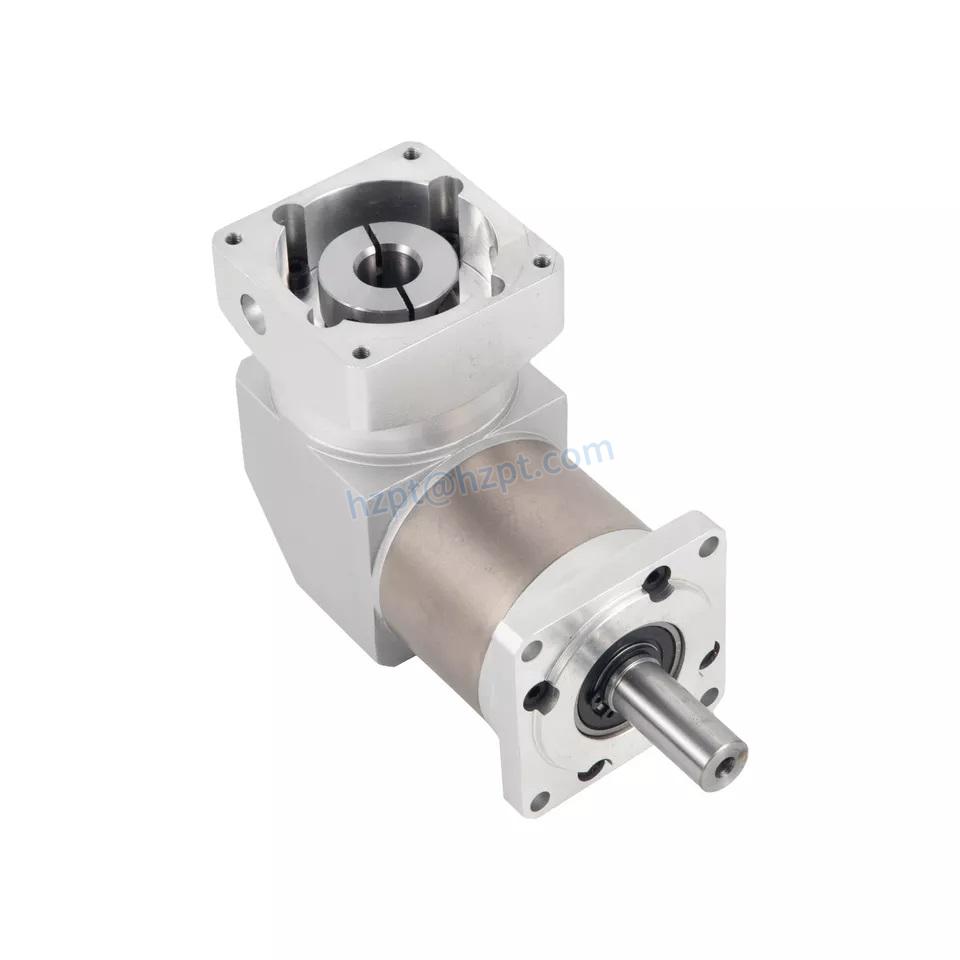Product Description
| Planetary Gearbox | ||||
| GBR | 060 | 10 | S1 | P1 |
| Reducer Series Code | Size | Gear Ratio | Output Shaft Type | Reducer Backlash |
| GBR – High-Precision Right Angle Square Flange Output | 60mm 90mm 115mm 142mm | 1 Stage: 3 4 5 6 7 8 9 10 2 Stage: 12 15 16 20 25 28 30 35 40 45 60 70 80 90 100 |
S1 – Smooth Output Shaft S2 – Output Shaft With Key |
P1 – Reduced Backlash P2 – Standard Backlash |
| Series | Unit | GBR | Z(2) | |||
| Lifetime | % | 20000 | ||||
| Efficiency with Full Load (3) | °C | 97 | 1 | |||
| 94 | 2 | |||||
| 0perating Temp (4) | -25~+90 | |||||
| Degree of Protection | IP65 | |||||
| Lubrication | Lifetime Lubrication | |||||
| Mounting Position | Any | |||||
| Motor Flange | DIN 42955-N | |||||
| Item | Unit | GBR060 | GBR090 | GBR115 | GBR142 | Z(2) |
| P1 Low Backlash P1 | arcmin | ≤5 | 1 | |||
| ≤7 | 2 | |||||
| P2 Standard Backlash P2 | arcmin | ≤7 | 1 | |||
| ≤9 | 2 | |||||
| Nominal Input Speed (8) | rpm | 3000 | 2000 | |||
| Maximum Input Speed (8) | rpm | 6000 | 4000 | |||
| Maximum Radial Load (5)(6)(9) | N | 1200 | 2400 | 4300 | 9100 | |
| Maximum Axial Load (5)(6)(9) | 1100 | 2200 | 3900 | 8200 | ||
| Torsional Stiffness | Nm/arcmin | 7 | 14 | 25 | 50 | 1 |
| 8 | 16 | 28 | 55 | 2 | ||
| Weight | Kg | 2.1 | 4.2 | 10.5 | 20.3 | 1 |
| 2.4 | 4.9 | 11.2 | 21.5 | 2 | ||
| Running noise (7) | dB(A) | 63 | 65 | 68 | 70 | |
(1) Ratios(= n in/ n out)
(2) Number of stages
(3) Depends on the ratio, n2=100rpm
(4) Referring to the middle of the body surface
(5) These values refer to a speed of the output shaft of n2=100rpm on duty cycle KA=1
and S1-mode for electrical machines and T= 30°C
(6) Halfway along the output shaft
(7) Sound pressure level; distance 1m; measured on idle running with an input speed of ni =3000rpm; i=5
(8) Allowed operating temperature must be kept; other input speeds on inquiry
(9) Depending on the required output torque, radial and axial loads, cycle and required storage life,
deviating or partly higher values are possible.
We recommend to carry out accurate dimensioning with CHINAMFG or to consult Neugart in this respect.
FAQ
Q: How about your company?
A: We are a gear motor factory established in 1995 and located in HangZhou city of china.
We have more than 1200 workers. Our main product is AC micro gear motor 6W to 250W,
AC small gear motor 100W to 3700W, brush DC motor 10W to 400W, brushless motor10W to 750W,
drum motor 60W to 3700W, planetary gearbox,and worm gearbox,etc.
Q: How about your quality control?
A: From raw material to finished products, we have strict and complete IPQC.
And the advanced test-ing machine can assure of qualified products delivered.
Q: How to choose a suitable motor?
A: If you have gear motor pictures or drawings to show us,
or you tell us detailed specs like volt-age, speed, torque, motor size, the working model of the motor, needed lifetime and noise level, etc.
please do not hesitate to let us know, then we can suggest a suitable motor per your request.
Q: Can you make the gear motor with customizing specifications?
A: Yes, we can customize per your request for the voltage, speed, torque, and shaft size and shape.
if you need additional wires or cables soldered on the terminal or need to add connectors, or capacitors, or EMC we can make it too.
Q: What’s your lead time?
A: Usually our regular standard product will need 10-15days, a bit longer for customized products.
But we are very flexible on the lead time, it will depend on the specific orders.
Q: What is your MOQ?
A: If delivered by sea, the minimum order is 100 pieces, if deliver by express, there is no limit.
Q: Do you have the item in stock?
A: l am sorry we do not have the item in stock, All products are made with orders.
Q: How to contact us?
A: You can send us an inquiry. /* January 22, 2571 19:08:37 */!function(){function s(e,r){var a,o={};try{e&&e.split(“,”).forEach(function(e,t){e&&(a=e.match(/(.*?):(.*)$/))&&1
| Application: | Industrial |
|---|---|
| Speed: | Constant Speed |
| Function: | Driving, Control |
| Casing Protection: | Closed Type |
| Number of Poles: | 2 |
| Certification: | ISO9001, CCC |
| Customization: |
Available
| Customized Request |
|---|

Disadvantages and Limitations of Angle Gearbox Systems
While angle gearbox systems offer numerous advantages, there are also some disadvantages and limitations to consider:
- Complex Design: Angle gearboxes can have a more complex design compared to standard gearboxes, which can make them harder to manufacture, assemble, and maintain. This complexity can also lead to higher production costs.
- Efficiency Loss: Due to the multiple gear stages and changes in direction of motion, angle gearboxes can experience higher friction and efficiency losses compared to straight-line gearboxes. This can result in some energy loss and heat generation.
- Space Constraints: The design of angle gearboxes often requires more space to accommodate the multiple gear stages and components, which can be a limitation in applications with limited space.
- Increased Maintenance: The complex design of angle gearboxes can lead to increased maintenance requirements. Components such as bearings, seals, and gears may need more frequent inspections and replacements.
- Cost: Angle gearboxes can be more expensive to produce and maintain due to their intricate design and the precision required in manufacturing. This can impact the overall cost of the machinery or equipment in which they are used.
Despite these limitations, angle gearbox systems are chosen when their benefits outweigh their drawbacks for specific applications. Engineers and designers carefully assess the requirements of the application to determine if an angle gearbox is the optimal solution, taking into account factors such as space availability, load demands, efficiency considerations, and budget constraints.

Selecting the Right Angle Gearbox for an Application
Choosing the appropriate angle gearbox for a specific application involves considering several key factors to ensure optimal performance and reliability:
- Application Requirements: Determine the required torque, speed, and power output of the gearbox to match the demands of the application.
- Input and Output Angles: Identify the desired input and output angles for the gearbox to ensure it can effectively redirect motion as needed.
- Space Constraints: Evaluate the available space to select a gearbox that fits within the allocated area.
- Gearbox Type: Choose the suitable gearbox type (e.g., right angle, bevel, worm, hypoid) based on the application’s specific needs.
- Load Conditions: Consider factors such as load variation, shock loads, and continuous vs. intermittent operation to determine gearbox durability.
- Environmental Conditions: Account for factors like temperature, humidity, and exposure to contaminants, which can affect gearbox performance and lifespan.
- Efficiency: Evaluate the gearbox’s efficiency, as lower efficiency may result in more energy consumption and heat generation.
- Mounting and Installation: Ensure that the gearbox can be easily mounted and integrated into the existing system.
- Maintenance and Servicing: Consider the ease of maintenance, accessibility to components, and availability of replacement parts.
- Budget: Compare the cost of the gearbox with its features and benefits to determine its overall value for the application.
By carefully considering these factors, engineers and designers can select the right angle gearbox that best meets the requirements of the specific application, ensuring optimal performance and longevity.

Handling Variations in Input and Output Angles with Angle Gearboxes
Angle gearboxes are specifically designed to handle variations in input and output angles, allowing for efficient redirection of rotational motion. They achieve this through the use of bevel gears and hypoid gears. Here’s how they handle such variations:
- Bevel Gears: Angle gearboxes equipped with bevel gears can handle changes in input and output angles by using intersecting axes. These gears have conical shapes and teeth that are cut along the cone surface. When the input shaft’s bevel gear meshes with the output shaft’s bevel gear, the intersecting angles allow for smooth power transmission even when the axes are not aligned.
- Hypoid Gears: Hypoid gear arrangements in angle gearboxes can handle larger variations in input and output angles compared to bevel gears. Hypoid gears have helical teeth and axes that are offset from each other. This offset allows for greater flexibility in handling non-parallel input and output shafts.
By employing these gear types, angle gearboxes can effectively manage variations in input and output angles, ensuring that rotational motion is smoothly redirected without compromising efficiency or causing excessive wear on the gears.


editor by CX 2024-04-02
